_We may earn revenue from the products available on this page and participate in affiliate programs. Learn more ›
_
One of my long-time pet peeves is the habit of framing a squirrel hunt as a simple tune-up for big game season. Truth is, head-shooting a limit of bushytails with a rimfire requires way more skill than shooting a whitetail out the window of a box blind. Squirrel hunting is the most accessible form of hunting we have in the East, but that doesn’t mean it’s always easy. Still, squirrel hunting can be a great way to get a new hunter some hands-on experience.
The best thing about squirrel hunting is that it abounds with opportunity. Where you might blow your chances at a whitetail should you spook it, squirrels tend to come back after running away. And, if you’re in the right spot, you can find another squirrel to chase. This lets new hunters practice important hunting skills like stalking, listening, and finding a good rest for a shot over and over again during a single day in the woods.
For experienced hunters, squirrel hunting can be as hard as you want it to be. Taking on skittish bushytails in the dead of winter, when there are no leaves on the trees, isn’t easy, nor is going after squirrels with a rifle during the early season, when heavy foliage doesn’t allow for many shot opportunities. Whatever your skill level and however you want to hunt squirrels, here’s a guide to everything you need to know about squirrel hunting.
Squirrel Hunting Table of Contents
Where to Find Squirrels
What Squirrels Eat: Hunter’s Guide to Mast
The Best Methods for Squirrel Hunting
The Best Squirrel Hunting Dogs
The Best Guns for Squirrel Hunting
The Only Two Squirrel Recipes You Need to Know
Frequently Asked Questions
Where to find Squirrels
There are more than 65 types of squirrels
in America. For our purposes, we’re mostly going to focus on gray squirrels and fox squirrels, which largely inhabit the eastern and midwestern U.S.—from Maine to Flordia, and east Texas to North Dakota—though you aren’t likely to find fox squirrels in the northeast.
Squirrels prefer habitats with ready access to mast-producing hardwoods. In other words, they like to be around trees that drop acorns, beechnuts, hickory nuts, or walnuts. If you find these trees, look for squirrel nests in the branches. They’ll be clumps of leaves packed into the crotch of a tree.
Like a lot of game animals, squirrels are crepuscular, meaning they’re most active during dawn and dusk. The best time to hunt squirrels is in the early morning and late afternoon before sundown. Depending on the time of year, squirrels will be more or less active. One of the best times to hunt squirrels is during the fall, when there are still a few leaves on the trees and the squirrels are busy stashing nuts for the winter. In the dead of winter, squirrels are less active because of the cold, and the open canopy makes them susceptible to predators like hawks and eagles.
What Squirrels Eat: A Hunter’s Guide to Mast
Diehard squirrel hunters let mast lead them to the mother lode. Here’s a basic guide to what the critters are munching throughout fall.
Early Season: Late August–October
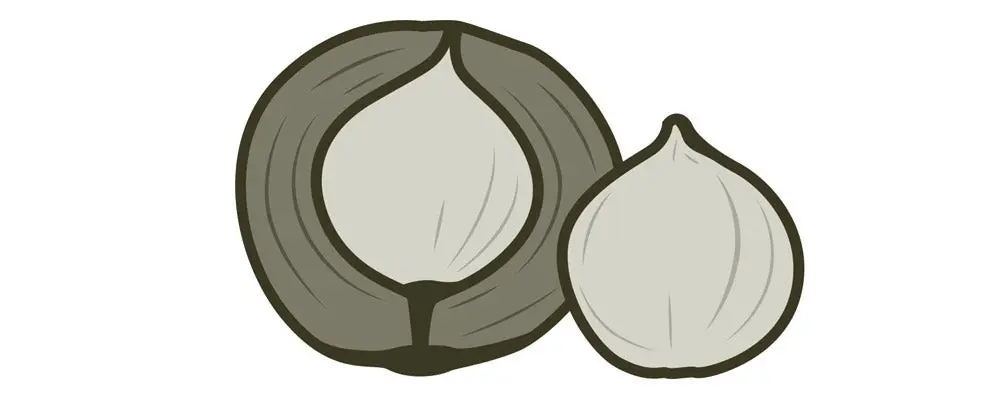
Hickory nuts are an early-season favorite. T.M. Detwiler
Scout mature hardwood timber for hickory nuts, a favorite of squirrels. They like shagbark and pignut best of all, but any hickory tree with nuts will draw them in.
Midseason: September–November
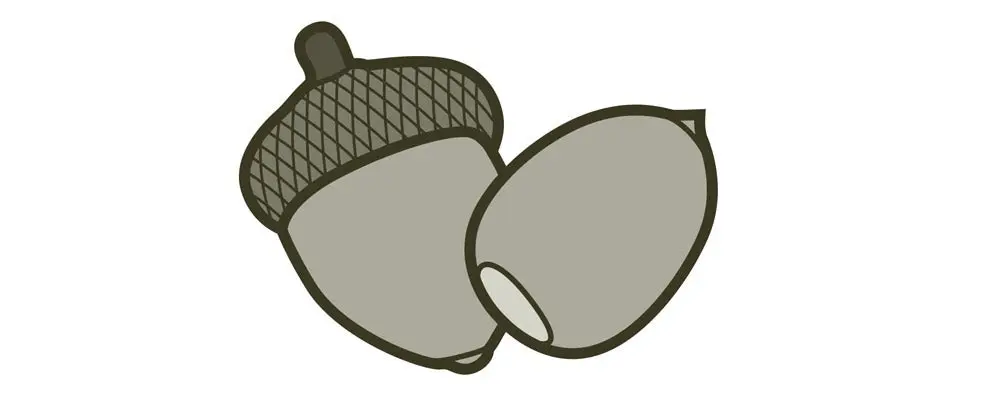
Squirrels will hit the white oaks especially hard. T.M. Detwiler
By mid-fall, squirrels will likely shift from hickories to acorns. They have a marked preference for white oaks, followed by red oaks. Beechnuts are appealing now, too.
Late Season: November–January

Black walnuts drop in late winter. T.M. Detwiler
As food gets scarcer, look for squirrels on the ground digging up some of their cached nuts, or scavenging along field edges. Target black walnut trees, too, since they don’t drop all their mast until late winter.
The Best Methods for Squirrel Hunting
Squirrel hunting can take on many forms. Here are six methods, from the basic to the extraordinary:
How to Stalk Squirrels
There are two classic ways to hunt squirrels—sit and wait, or stalk. Stalking places an emphasis on woodsmanship, It’s really big-woods deer hunting in miniature—and a great tune-up for the big-game season. It also happens to be a great way to start a young hunter.
Rather than sitting in a blind for hours (for what may be a single shot), the new hunter learns how to move slowly and quietly in the woods. They’ll also have the opportunity to shoot more than once (which reaffirms the value of making accurate shots). Successful squirrel stalking comes down to moving slowly and keeping your ears and eyes open. Here are a few things to remember while slinking around the squirrel woods:
When the trees are still in full foliage, it’s difficult to see squirrels. Move slowly and look for moving leaves that indicate squirrels scurrying along the limbs above you. If you hear cuttings (the sound of falling debris from feeding squirrels), you’re in business.
When you spot a squirrel, slowly move into position for a clear shot. Because the target is so small, you really need to practice before the season opens, and that helps in deer season.
If you’re stalking squirrels with a rifle, a crucial thing to keep in mind is the importance of a backstop. Remember, you’re shooting up, and you want to make sure the bullet hits the tree if you miss. Never shoot skylined squirrels and always make sure there’s enough tree trunk behind the animal to catch the bullet. Though headshots are preferable (less damage to the meat), take the shoulder shot if needed. —Slaton L. White
How to Snipe Squirrels from 100 Yards
Veteran Hunter Ricky King chases all manner of critters around his home state of Kentucky, but he’s best known for sniping Eastern gray squirrels at 100-plus yards, with the help of his tricked-out Anschutz .17 Mach 2. King got his start at long-range squirrel hunting 34 years ago, after a severe three-wheeler accident left him paralyzed from the waist down. He refused to let it keep him out of the woods. “I’d been hunting and fishing my whole life,” he says. “I wasn’t about to stop.” He learned how to navigate the woods with an ATV, but the machine’s limited mobility made getting close to game tough. So King adapted. To consistently shoot squirrels at deer hunting distances, he worked out a deadly system that can help you drop more far-off critters, too.
King takes particular care in sighting in his squirrel rig and stresses the importance of using a high-powered scope to ensure hyperaccurate shots. “I like to count their eyelashes at 100 yards,” he says. He zeroes his .17 Mach 2 dead nuts at 25 yards. That way, it’ll hit 1⁄2 inch high at 50 yards, a fuzz north at 75, and center-punch the X again at 100. You’ll need to be shooting supertight groups from a football field away before hitting the woods, he says, given the small size of a squirrel’s cranium.
The evening before a hunt, King scouts for a mast-heavy tree where squirrels may be hanging out. He sets up well before sunrise on the forage hotspot, making sure that he has a clear view of the ground, since that’s where most squirrels will be feeding in mid to late fall. He shoots from a utility box mounted to the front of his ATV, with rifle-rest bags to stabilize his gun, and also keeps a tripod ready at his side, should a squirrel flank him. You can try a similar setup, by lying prone or resting on a flat surface, with a tripod handy should you need to adjust or move.
A big part of King’s strategy is staying patient and calm once he begins to pull the trigger. It’s easy to let a miss frazzle you, he says, but there’s no reason to let it. “Young squirrels won’t even clear off a tree after a shot, but the older ones will,” he says. You just have to wait them out, he adds. “They’ll be back.” —Michael R. Shea
How to Hunt Squirrels by Boat

A float hunt for squirrels allows you to cover ground quietly. T.M. Detwiler
Squirrels love to feed along creek banks and loaf in the treetops above a river, which is why hitting the water with a boat and a buddy is a guaranteed way to help fill your limit. That said, squirrels are well aware that when they hang out by the shoreline, they’re exposed to every fang and talon that prowls overhead—not to mention your load of #6s—so you have to bring your A game. Here’s how to do more than luck out on a squirrel or two during an early-morning float.
The better you hide your boat—be it a canoe, johnboat, or skiff—the more chances you’ll have at squirrels. Sure, you might kill a few with your standard duck-boat setup, but if you’re serious about killing a mess of squirrels, commit to fully covering your craft. First, drape camo netting over the gunwales to keep the hull from reflecting morning sunlight. Then, prop up vertical cover—river cane, bamboo, pruned tree branches—in the bow and stern and along the gunwales. Beech branches work great, since they hold brown leaves well into winter, as do evergreen holly boughs. Fine-tune things by visualizing the perspective of a wily, neurotic critter looking down from 30 feet overhead. Don’t neglect to camouflage the handles and blades of your paddle, either. Nothing will send a squirrel scurrying away faster than a paddle flash.
You may feel tempted to float down the middle of a creek so that you can look far downstream to catch a glimpse of feeding squirrels. The problem is that these squirrels are often looking far upstream, right at you. Instead, tuck your boat close to the bank and scull slowly downstream. That way, you’re more likely to close the distance on squirrels feeding in cover. Plus, those sunny banks can also grow thick with soft mast. Stay on the inside edges of any river bends, listening for squirrels on the ground, and be ready to shoot. Often, a squirrel will look at your boat for a second to decide whether you’re a floating tree or a threat, giving you a window to fire.
I prefer to squirrel hunting from a boat with a short, quick-pointing over/under, like the Stevens 555, rather than a long autoloader. Compact o/u’s are easy to swing in a johnboat or canoe, and gunning with two chokes—one open for close-range shots, the other a bit tighter for treetop targets—comes in handy. Fair warning: Shooting seated in a boat is no cinch. Focus on swinging your torso without putting weight on your feet.
Don’t forget the landing net. Once you get in the groove of working the bank, you’ll want to make quick, easy work out of scooping squirrels from the current, so you can get back in the action. —T. Edward Nickens
How to Go Squirrel Hunting With a Bow
Bowhunting for squirrels not only affords tons of shooting opportunities, but it also sharpens your eye as a marksman, since squirrels seldom hold still for long. Before you start launching arrows into the treetops, however, you’ll need the specialized gear designed for targeting the animals. Flu-flu arrows are essential. These arrows fly at standard velocities for 20 to 30 yards, then quickly decelerate and parachute to the ground, making for easy, safe recoveries. You’ll also want specialized small-game points that resist breaking and sticking in timber, such as Saunders Archery’s rubber bludgeons or Zwickey’s spring-arm Judo points.
Once you’re geared up, start out by slipping through the hardwoods quietly while scanning the treetops. Stay on the lookout for acorn and nut pieces littered on the ground—a good sign squirrels are close—and listen for chittering and stirring leaves. Freeze if a squirrel suddenly appears within range. They see movement more than form, so if you hold still, there’s a good chance you’ll get a shot. If a squirrel is farther than 30 yards, wait until it turns away for a moment and then close the distance by stepping between bare or damp spots on the earth. When in range, crouch or kneel beside a tree from where you can draw back and let an arrow fly.
How to Hunt Squirrels with a Handgun
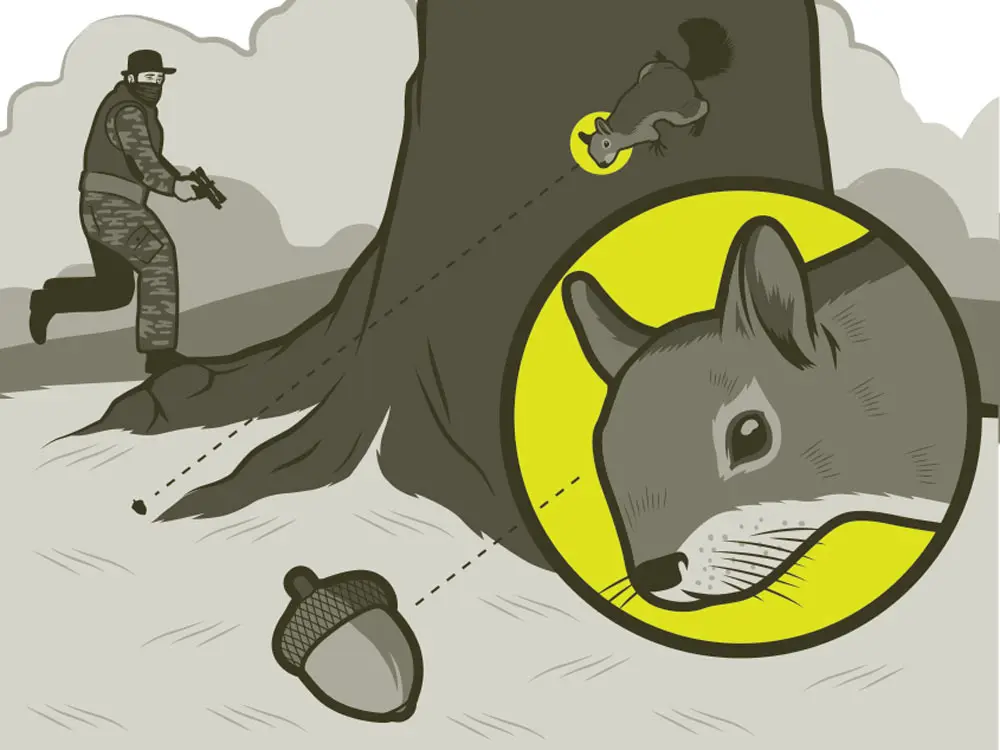
Old-growth hardwoods are a hotspot. T.M. Detwiler
Stalking squirrels with a rifle is fun, but extreme small-game hunters know nothing beats shooting a limit from 10 feet with a pistol. If you’re up for the challenge, you had better be ready to make a charge. Squirrels do most of their foraging on the ground throughout fall and winter, but right now is the best time for this tactic because squirrel numbers are high and there’s still hanging foliage for cover.
Watch the forecast and don’t make hunting plans until you get a cool, drizzly day with a light breeze. Those conditions portend slow-moving cold fronts and put critters on the move. The damp forest floor and rustling branches also make it easy for you to flit around like a squirrel-hunting ninja.
Target old-growth hardwood forests with large mast-producing trees but sparse undergrowth. You probably won’t be able to hear foraging squirrels on the ground, but you should be able to see them from a distance. Ease through the woods slowly, watching and waiting more than you walk. Once you spot a squirrel, hold still, even if you have a good shot. Pulling off a charge will be worth the wait.
Squirrels are malcontent creatures. They’ll search for the perfect nut, find it, chew on it for a minute, and then throw it aside for another. All this busywork usually takes place at the base of a big tree, which you can use to your advantage. As you watch the squirrel, slowly position yourself so that the trunk is between you and the critter, blocking you from view. Even if the squirrel does spot you, as long as you’re wearing camo and moving slowly, it probably won’t pay you any attention.
Once in place, give the squirrel a few seconds to find a worthy nut and really settle into its feast on the far side of the tree. Then, staying out of view, make long, soft strides to close the distance quickly. Once you’re within a couple yards, stop and wait for the squirrel to come around again. Once it does, it may not notice you at all. But if it happens to, it’ll likely just jump on the nearest tree for a better look. And that’s an easy shot for a squirrel ninja like you. —Will Brantley
How to Go Squirrel Hunting With Dogs
Mostly a southeastern tradition, squirrel hunting with dogs is a fast, loud, action-packed way to hunt bushytails. The basic premise is simple and plays on a squirrel’s impulse to run up a tree and hide. First, you cut the dogs loose. Then, let them find a squirrel. Wait until they chase said squirrel up a tree, then go shoot the squirrel. Good dogs will say at the bottom of a tree and bark at the squirrel to alert the hunter and keep the squirrel in one place.
While this sounds easy, it isn’t. You need a dog that can track squirrels by scent and sight. Those dogs are typically pretty high-strung to match their quarry’s disposition. Once the squirrel is up the tree they can be difficult to spot. Instead of silently ambushing a squirrel by stalking or one of the methods above, you’ve just scared the daylights out of him and he’s going to do his best to hide in the tree.
The best ways to find a hidden squirrel with more eyeballs. That’s one of the reasons why squirrel doggers like to hunt in groups. Often, a squirrel’s most striking attribute—its bushy tail—betrays them. Look for it hanging out of the crotch of a tree or waving in the breeze like a flag. The rest is all about good shooting. Try to have someone in the group with a shotgun for the runners and jumpers and at least one person with an accurate .22 for more precise shots. —M.E.
The Best Squirrel Hunting Dogs
Squirrel hunting with dogs has all the excitement of old-time coon hunting, but it’s easily managed on public lands and smaller forest tracts. Below, three squirrel-dog breeders share their thoughts on the best dogs for treeing bushytails.
Feist
Lee Moore of the Mississippi Delta
likes a small, 20- to 25-pound feist. He says a small dog is easy to handle, and you can fit more than one in a dog box. Most feists use their eyes more than a cur, and tree the squirrel a little quicker. Moor doesn’t like loud, hard-barking dogs, either because they keep him from hearing what other hunters are saying or where they’re moving.
Blackmouth Cur
Paul Hillis of Texas prefers a Ladner blackmouth cur
. Their lines go back more than 200 years. They vary in size up to 90 pounds, but he likes a 40- to 50-pound dog. Bigger dogs will tire out faster, and they tend to go around thickets that a little dog will go through. Blackmouth curs have amazing winding ability. They’ll walk on their two hind legs, like a kangaroo, with their nose in the air trying to smell a squirrel.
Mountain Cur
Chuck Loudin of West Virginia runs purebred original mountain curs
. He says it’s because he’s hound guy, and he likes the similarities between treeing walkers and original mountain curs. Curs tend to range out a bit farther, and they run a track by scent. He likes watching his curs work a good track. When they tree, they’re up on the tree, staying tight and barking plenty, like a hound. —T.E.N.
Best Guns for Squirrel Hunting
A .22 LR that will constantly group at around an inch at 25 to 50 yards is just the tool for head-shooting squirrels
. But even though shooting squirrels with sniper-like precision is part of the fun of squirrel hunting, it isn’t everything. And some hunters either don’t have a .22 that can do that, or don’t feel comfortable shooting into the trees with a rifle. The good news is that most hunters already have the perfect gun to hunt squirrels. A shotgun with a modified choke loaded with #5 or #6 field loads will do the trick. And for those who can sneak into close range, a .410 with a full choke works well, too. When given an option between hunting squirrels with a shotgun or rifle, a lot of dedicated squirrel gunners will opt for the latter—and even get pretty heated should you mention squirrels and scatter guns
in the same sentence. But some hunters take their squirrel hunting guns to a whole other level. Here are a couple of examples:
The Ultimate Squirrel Pistol
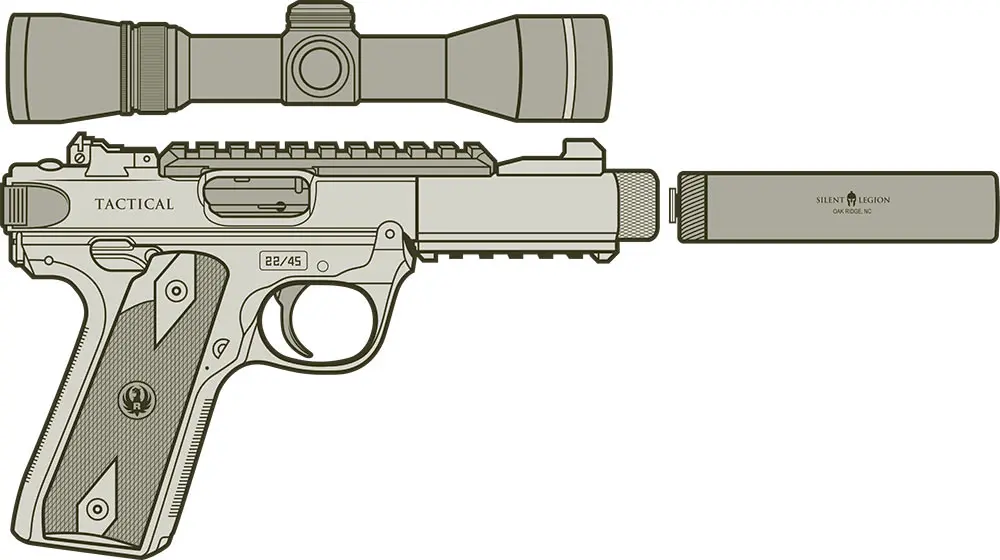
The Ruger Mark IV 22/45 Tactical. T.M. Detwiler
, a tactical version of Ruger’s legendary .22 pistol, has a threaded 4.4-inch barrel with rails on top and underneath. You probably don’t need a tactical flashlight for squirrel hunting, but it could come in handy for shooting big bullfrogs in the off-season. For precision squirrel shooting, a variable-power pistol scope like the Leupold VX-3 Handgun 2.5–8x32mm
makes sense, since you can dial up to 8X and clearly see a squirrel’s head high in a hickory tree. Without the suppressor, this scope will probably hang over a 4-inch gun’s muzzle. Choose your barrel length accordingly. Trust me, you’ll be shooting this pistol a bunch, and it’ll be surprisingly loud, so putting a can on it makes a world of sense. The Silent Legion Rimfire Direct Thread weighs just 2.7 ounces and costs just $315, in addition to the required stamps and fees, of course. —W.B.
The 100-Yard Squirrel Rifle
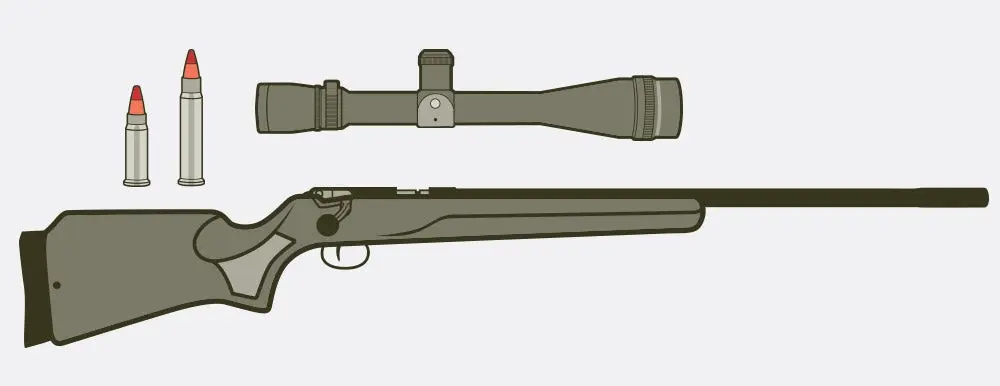
The Savage Mark II FV in .17 Mach 2. T.M. Detwiler
Hitting a squirrel’s head from 100 yards depends on the rifle as much as the shooter. For caliber, the .17 Mach 2 (a.k.a. .17 HM2) is just the ticket. It’s basically a .22 LR necked down to .17 caliber. The round reaches velocities of 2100 fps, nearly twice as fast as the standard-velocity .22 LR, and is laser flat to 125 yards. Should you pull a shot and hit on a squirrel’s body, it also won’t damage the meat nearly as much as the more popular .17 HMR. An Anschutz Model 1502 Heavy-Barrel Classic is the ideal 17 Mach 2 squirrel rifle. But it’s been discontinued and it’ll set you back more than $1,500 if you can find one. Fortunately, Savage still chambers the .17 Mach 2 in the affordable Mark II FV
, Top the rifle with a Leupold VX-3i 6.5–20x40mm EFR CDS scope
, and you’ll be able to watch a squirrel blink from a football field away. —M.R.S.
The Only Two Squirrel Recipes You Need to Know
With any luck, you’ll have a mess of squirrels on your hands after a long day in the woods. The key to cooking squirrels is all about the age of the animal. Younger squirrels are more tender and better for the fryer. After hunting squirrels for a season or two, you’ll be able to identify the young ones from the old. They’re typically smaller and usually dumber that older ones—and easier to pick off earlier in the season. Older squirrels can be tough to hunt and even tougher to eat. They’re best in recipes that invovle slow cooking like soups, stews, and pot pies. Here are two recipes, one for older squirrels and one for younger squirrels, that will keep you heading back to the hardwoods for more ingredients.
The Best Recipe for Older Squirrels
Larry Brown’s Squirrel, Biscuits, and Gravy (Serves four)
The late Larry Brown, the author of Joe, Billy Ray’s Farm, and seven other classics of Southern literature, had a saying. When things were difficult, complicated, aggravating, or vexing in one way or another, he’d say, “They ain’t squirrels, baby.” Squirrels, for Larry, were the antithesis of all that: They were a joy to hunt, a joy to cook, and a joy to eat. Hunting and eating them was one of life’s simple pleasures-along with bream fishing, slow back-roads driving, drinking with pals, and cradling his grandchildren. On numerous mornings he greeted guests with a plate of squirrel, biscuits, and gravy, his signature dish, usually made with grays his sons had killed. Nothing ever tasted better, or will again.
Ingredients
2 squirrels (about 1 pound each), dressed and quartered
2/3 cup flour for dredging, plus roughly 1/4 cup for gravy
5 slices bacon
Salt and freshly ground pepper
Biscuits
2 cups flour
1 teaspoon sugar
1 teaspoon salt
2 teaspoons baking powder
1/2 teaspoon baking soda
1/2 cup vegetable shortening, chilled
3/4 cup buttermilk
3 tablespoons butter, melted
1. Parboil the squirrel pieces: Place them in a large pot and add enough salted water to cover. Bring to a simmer and cook until the meat is very tender but still intact-1 to 2 hours. Remove them from the water and set aside to cool.
2. In a large cast-iron skillet or Dutch oven, fry the bacon slices over medium heat until they’re crispy and all the fat has been rendered. Reserve the bacon for another use. In a wide, shallow bowl or pan, season 2/3 cup of flour (or more as needed) with salt and pepper. Dredge the squirrel pieces in it, shaking off any excess, and place them in the bacon grease. Reduce heat to medium-low and cook the squirrel until lightly browned on all sides, about 10 minutes per side. You may have to do this in batches; add butter to the pan if the grease seems insufficient.
3. In the meantime, make the biscuits: Preheat the oven to 400¿¿. Mix the dry ingredients in a bowl. Divide the shortening into several pieces and cut it into the dry ingredients until the mixture resembles coarse crumbs. Make a hole in the center and pour in the buttermilk. Using your hands, fold the dry mixture into the buttermilk until you have a sticky dough. Turn the dough onto a floured surface and fold it over on itself to form layers. Flatten it with your hands until it’s about 3/4 inch thick. Using a biscuit cutter or an upside-down glass, cut rounds out of the dough. Transfer the rounds to a sheet pan and brush with melted butter. Bake for 15 minutes until golden brown.
4. When the squirrel pieces are done, remove them to a plate or keep them warm in a low oven. Pour off the excess grease, keeping about 1/4 cup in the pan. Increase the heat to medium-high and add 1/4 cup of flour, stirring constantly and scraping up any browned bits until the mixture turns an oaky shade of brown. Add 3/4 cup of cold water and stir until a thick gravy forms; if it’s too thick, add more water. Salt and pepper to taste. Serve the squirrel and biscuits with the gravy on the side.
The Best Recipe for Younger Squirrels:
Pork Rind-Crusted Fried Squirrel with Molasses Red-Eye Gravy (Serves four)
John Currence, the James Beard Award-winning chef of the City Grocery in Oxford, Mississippi, conceived of this crushed pork-rind coating for fried chicken, but it works even better crusting the more flavorful meat of young gray squirrels. To make “pork rind powder,” drop a bag or two of rinds in the blender and pulverize until you have coarse, sandy-textured bits. Currence recommends Brim’s Hot Pork Rinds and serves this dish with hot cornbread for sopping up the red-eye gravy.
Ingredients
4 young squirrels, dressed and quartered
1 yellow onion, roughly chopped 2 stalks celery, roughly chopped
2 carrots, roughly chopped
6 cloves garlic, peeled
1 gallon water
1 cup apple cider vinegar
1-1/2 cups lard
1-1/2 cups peanut or vegetable oil
3 cups all-purpose flour seasoned with salt, black pepper, paprika, onion powder, and garlic powder
2 cups pork rind powder (see recipe headnote)
2 cups milk
3 eggs, lightly beaten
3/4 tablespoon freshly cracked black pepper
Salt, cayenne powder, and Tabasco, to taste
Tasso and Molasses Red-Eye Gravy
1/3 cup tasso or other thick-sliced ham, diced
1/2 cup bacon, diced
1 tablespoon flour
1-1/4 cups beef stock
3/4 cup strong black coffee
1/3 cup Coca-Cola
2 tablespoons molasses
1/2 teaspoon red pepper flakes
Salt and freshly ground black pepper, to taste
Directions
1. Generously season the squirrel pieces with salt, pepper, and cayenne; allow to sit for 2 hours.
2. Bring water, cider vinegar, onion, celery, carrot, and garlic to a boil, then boil for 15 minutes. Add the squirrel pieces and simmer for 12 to 15 minutes, until the meat is cooked through but not falling apart. Remove the meat. Drain the vegetables in a colander and discard them.
3. Make the red-eye gravy: In a large cast-iron skillet or pan, sauté the bacon and tasso over medium heat until all the fat is rendered. Whisk in the flour until it’s well combined, continuing to whisk over medium heat for 5 minutes. Stir in the beef stock, coffee, Coca-Cola, molasses, and red pepper flakes, bring to a simmer, and whisk constantly until gravy thickens. Season with salt and pepper to taste.
4. In a large cast-iron skillet or Dutch oven, heat the oil and lard to 325 degrees F, or until a pinch of flour bubbles in the oil.
5. Whisk together the milk and eggs with a dash of Tabasco. Dust the squirrel in the seasoned flour and set aside. Add the pork rind powder to the remaining seasoned flour and combine well. Dunk the squirrel in the egg wash, then dredge them in the pork rind and flour mixture, shaking off any excess. Fry the pieces until golden brown, working in batches. Drain on paper towels and serve immediately with gravy on the side, and cornbread if desired.
Frequently Asked Questions
What does squirrel taste like?
I hate to say it, but a lot like chicken, with deeper in flavor. Squirrels have a dark meat, similar to chicken thighs. They’re also lean, without a lot of fat. You can slow cook them until they’re falling-off-the-bone tender or deep fry younger squirrel parts like chicken wings. In other words, they’re delicious.
What size 12 gauge shot for a squirrel?
You can’t go wrong with #5 or #6 field loads out of a 12 gauge. Either will give you an open enough pattern to damage less meat and enough power to ethically kill a squirrel. Shoot from a modified choke at around 35 yards and under.
What’s the best time to hunt squirrels?
In the early morning or late afternoon. Squirrels are busiest during the sunrise and sunset and you’re more likely to see them then. Squirrel season is pretty long, and depending on the time of year you’ll see more or less squirrels. See above for a breakdown of what squirrels are eating during different times of the year.
What’s the tastiest part of a squirrel?
It’s all pretty good, but you’ll find the most meat on the back legs. The squirrel’s saddle— or backstrap—though tiny, is quite good. And the front shoulders are nothing to scoff at.
![Field & Stream [dev]](https://images.ctfassets.net/fbkgl98xrr9f/1GnddAVcyeew2hQvUmrFpw/e4ca91baa53a1ecd66f76b1ef472932b/mob-logo.svg)
